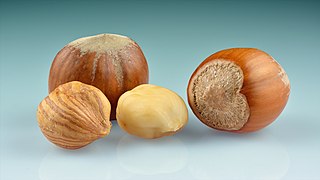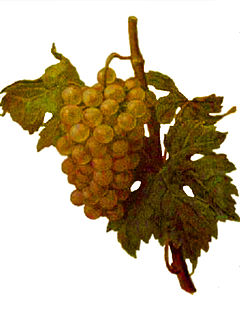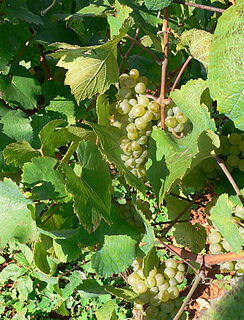 W
WBroccoli is an edible green plant in the cabbage family whose large flowering head, stalk and small associated leaves are eaten as a vegetable. Broccoli is classified in the Italica cultivar group of the species Brassica oleracea. Broccoli has large flower heads, usually dark green in color, arranged in a tree-like structure branching out from a thick stalk which is usually light green. The mass of flower heads is surrounded by leaves. Broccoli resembles cauliflower, which is a different, but closely related cultivar group of the same Brassica species.
 W
WA grape is a fruit, botanically a berry, of the deciduous woody vines of the flowering plant genus Vitis.
 W
WThe hazelnut is the fruit of the hazel and therefore includes any of the nuts deriving from species of the genus Corylus, especially the nuts of the species Corylus avellana. They are also known as cobnuts or filberts according to species. A cob is roughly spherical to oval, about 15–25 mm long and 10–15 mm in diameter, with an outer fibrous husk surrounding a smooth shell and a filbert is more elongated, being about twice as long as its diameter. The nut falls out of the husk when ripe, about seven to eight months after pollination. The kernel of the seed is edible and used raw or roasted, or ground into a paste. The seed has a thin, dark brown skin, which is sometimes removed before cooking.
 W
WHops are the flowers of the hop plant Humulus lupulus, a member of the Cannabaceae family of flowering plants. They are used primarily as a bittering, flavouring, and stability agent in beer, to which, in addition to bitterness, they impart floral, fruity, or citrus flavours and aromas. Hops are also used for various purposes in other beverages and herbal medicine. The hops plants have separate female and male plants, and only female plants are used for commercial production. The hop plant is a vigorous, climbing, herbaceous perennial, usually trained to grow up strings in a field called a hopfield, hop garden, or hop yard when grown commercially. Many different varieties of hops are grown by farmers around the world, with different types used for particular styles of beer. The first documented use of hops in beer is from the 9th century, though Hildegard of Bingen, 300 years later, is often cited as the earliest documented source. Before this period, brewers used a "gruit", composed of a wide variety of bitter herbs and flowers, including dandelion, burdock root, marigold, horehound, ground ivy, and heather. Early documents include mention of a hop garden in the will of Charlemagne's father, Pepin III.
 W
WMalingre Précoce is a white variety of grape of French origin used primarily as table grape and to some extent for wine. It was first cultivated by a French gardener named Malingre in the vicinity of Paris around 1840, who created it from seedlings of unknown origin. The term "précoce" indicates early ripening, and because of this property Malingre Précoce finds some use in cold climate viticulture. Malingre Précoce has been used as a crossing partner for many other grape varieties, including Madeleine Angevine and Zarya Severa.
 W
WMalvasia is a group of wine grape varieties grown historically in the Mediterranean region, Balearic Islands, Canary Islands and the island of Madeira, but now grown in many of the winemaking regions of the world. In the past, the names Malvasia, Malvazia, and Malmsey have been used interchangeably for Malvasia-based wines; however, in modern oenology, "Malmsey" is now used almost exclusively for a sweet variety of Madeira wine made from the Malvasia grape. Grape varieties in this family include Malvasia bianca, Malvasia di Schierano, Malvasia negra, Malvasia nera, Malvasia nera di Brindisi, Malvasia di Candia aromatica, Malvasia odorosissima, and a number of other varieties.
 W
WNero d'Avola is "the most important red wine grape in Sicily" and is one of Italy's most important indigenous varieties. It is named after Avola in the far south of Sicily, and its wines are compared to New World Shirazes, with sweet tannins and plum or peppery flavours. It also contributes to Marsala Rubino blends.
 W
WPears are fruits produced and consumed around the world, growing on a tree and harvested in late Summer into October. The pear tree and shrub are a species of genus Pyrus, in the family Rosaceae, bearing the pomaceous fruit of the same name. Several species of pears are valued for their edible fruit and juices, while others are cultivated as trees.
 W
WTaraxacum officinale, the dandelion or common dandelion, is a flowering herbaceous perennial plant of the dandelion genus in the family Asteraceae. The common dandelion is well known for its yellow flower heads that turn into round balls of many silver-tufted fruits that disperse in the wind. These balls are usually called "clocks" in both British and American English. The name "blowball" is also used.
 W
WThe turnip or white turnip is a root vegetable commonly grown in temperate climates worldwide for its white, fleshy taproot. The word turnip is a compound of turn as in turned/rounded on a lathe and neep, derived from Latin napus, the word for the plant. Small, tender varieties are grown for human consumption, while larger varieties are grown as feed for livestock. In the north of England, Scotland, Ireland, Cornwall and parts of Canada, the word turnip often refers to rutabaga, also known as swede, a larger, yellow root vegetable in the same genus (Brassica).
 W
WVitis vinifera, the common grape vine, is a species of flowering plant, native to the Mediterranean region, Central Europe, and southwestern Asia, from Morocco and Portugal north to southern Germany and east to northern Iran. There are currently between 5,000 and 10,000 varieties of Vitis vinifera grapes though only a few are of commercial significance for wine and table grape production.
 W
WZante currants, Corinth raisins, or simply currants outside of the United States, are raisins of the small, sweet, seedless grape cultivar Black Corinth. The name comes from the Anglo-French phrase "raisins de Corinthe" and the Ionian island of Zakynthos (Zante), which was once the major producer and exporter. It is not related to black, red or white currants, which are berries of shrubs in the genus Ribes and not usually prepared in dried form.